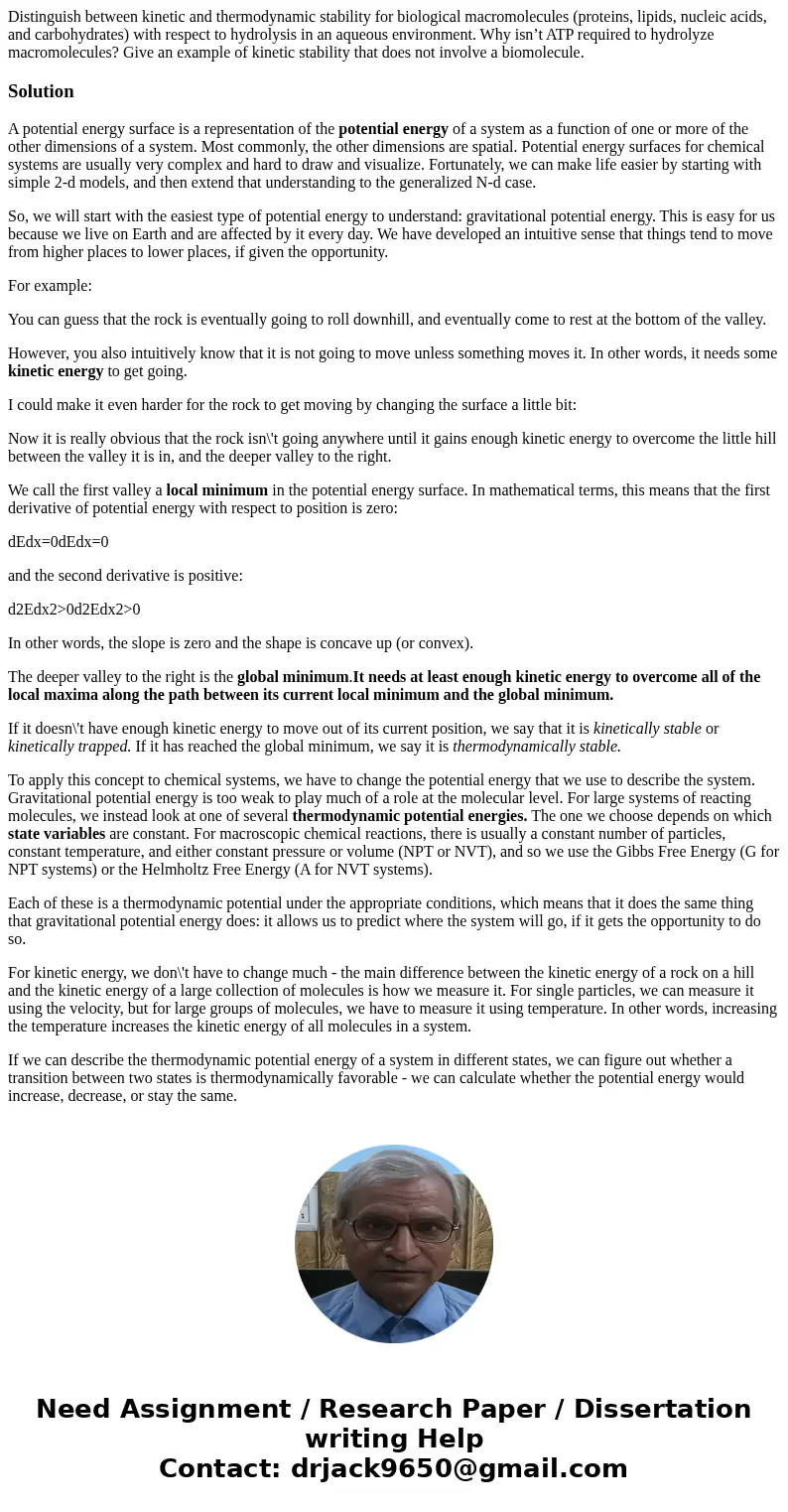Distinguish between kinetic and thermodynamic stability for
Distinguish between kinetic and thermodynamic stability for biological macromolecules (proteins, lipids, nucleic acids, and carbohydrates) with respect to hydrolysis in an aqueous environment. Why isn’t ATP required to hydrolyze macromolecules? Give an example of kinetic stability that does not involve a biomolecule.
Solution
A potential energy surface is a representation of the potential energy of a system as a function of one or more of the other dimensions of a system. Most commonly, the other dimensions are spatial. Potential energy surfaces for chemical systems are usually very complex and hard to draw and visualize. Fortunately, we can make life easier by starting with simple 2-d models, and then extend that understanding to the generalized N-d case.
So, we will start with the easiest type of potential energy to understand: gravitational potential energy. This is easy for us because we live on Earth and are affected by it every day. We have developed an intuitive sense that things tend to move from higher places to lower places, if given the opportunity.
For example:
You can guess that the rock is eventually going to roll downhill, and eventually come to rest at the bottom of the valley.
However, you also intuitively know that it is not going to move unless something moves it. In other words, it needs some kinetic energy to get going.
I could make it even harder for the rock to get moving by changing the surface a little bit:
Now it is really obvious that the rock isn\'t going anywhere until it gains enough kinetic energy to overcome the little hill between the valley it is in, and the deeper valley to the right.
We call the first valley a local minimum in the potential energy surface. In mathematical terms, this means that the first derivative of potential energy with respect to position is zero:
dEdx=0dEdx=0
and the second derivative is positive:
d2Edx2>0d2Edx2>0
In other words, the slope is zero and the shape is concave up (or convex).
The deeper valley to the right is the global minimum.It needs at least enough kinetic energy to overcome all of the local maxima along the path between its current local minimum and the global minimum.
If it doesn\'t have enough kinetic energy to move out of its current position, we say that it is kinetically stable or kinetically trapped. If it has reached the global minimum, we say it is thermodynamically stable.
To apply this concept to chemical systems, we have to change the potential energy that we use to describe the system. Gravitational potential energy is too weak to play much of a role at the molecular level. For large systems of reacting molecules, we instead look at one of several thermodynamic potential energies. The one we choose depends on which state variables are constant. For macroscopic chemical reactions, there is usually a constant number of particles, constant temperature, and either constant pressure or volume (NPT or NVT), and so we use the Gibbs Free Energy (G for NPT systems) or the Helmholtz Free Energy (A for NVT systems).
Each of these is a thermodynamic potential under the appropriate conditions, which means that it does the same thing that gravitational potential energy does: it allows us to predict where the system will go, if it gets the opportunity to do so.
For kinetic energy, we don\'t have to change much - the main difference between the kinetic energy of a rock on a hill and the kinetic energy of a large collection of molecules is how we measure it. For single particles, we can measure it using the velocity, but for large groups of molecules, we have to measure it using temperature. In other words, increasing the temperature increases the kinetic energy of all molecules in a system.
If we can describe the thermodynamic potential energy of a system in different states, we can figure out whether a transition between two states is thermodynamically favorable - we can calculate whether the potential energy would increase, decrease, or stay the same.
If we look at all accessible states and decide that the one we are in has the lowest thermodynamic potential energy, then we are in a thermodynamically stable state.
In your example using methane gas, we can look at Gibbs free energy for the reactants and products and decide that the products are more thermodynamically stable than the reactants, and therefore methane gas in the presence of oxygen at 1 atm and 298 K is thermodynamically unstable.
However, you would have to wait a very long time for methane to react without some outside help. The reason is that the transition states along the lowest-energy reaction path have a much higher thermodynamic potential energy than the average kinetic energy of the reactants. The reactants are kinetically trapped - or stable just because they are stuck in a local minimum. The minimum amount of energy that you would need to provide in the form of heat to overcome that barrier is called the activation energy.
We can apply this to lots of other systems as well. One of the most famous and still extensively researched examples is glasses.
Kinetic is how unwillingly something reacts.Thermodynamic is the energies involved, amount of gradient.
For example :
aluminium metal is kinetically much more stable than iron metal in damp air but thermodynamically much less stable.
ATP required to hydrolyze macromolecules:
Adenosine triphosphate, also known as ATP, provides the energy cells require in order to maintain metabolic pathways, DNA synthesis and repair, and any other cellular function necessary for survival. ATP itself is a reactive molecule that has three phosphate groups. Molecules tend toward stable states, converting to states of lower energies. Thus, ATP, a high-energy molecule, tends to lose a phosphate group and become adenosine diphosphate, ADP. In order for this to happen, an enzyme strips one phosphate group off of ATP, converting it to the more stable molecule ADP. This enzyme provides the energy of activation that enables ATP to become ADP, indicating that ATP is kinetically stable.


 Homework Sourse
Homework Sourse